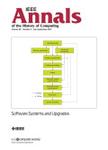版权所有:内蒙古大学图书馆 技术提供:维普资讯• 智图
内蒙古自治区呼和浩特市赛罕区大学西街235号 邮编: 010021

作者机构:Rumson NJ USA
出 版 物:《IEEE ANNALS OF THE HISTORY OF COMPUTING》
年 卷 期:1999年第21卷第4期
页 面:49-54页
核心收录:
学科分类:0808[工学-电气工程] 08[工学] 0712[理学-科学技术史(分学科,可授理学、工学、农学、医学学位)] 0812[工学-计算机科学与技术(可授工学、理学学位)]
主 题:manager Autobiography International Data Encryption Algorithm government agencies science fiction Bell Labs linear amplification Engineers temperature cycling Digital computers universities
摘 要:In the years before 1947, many if not most, engineers had the idea that it was physically impossible for a solid to amplify electrical signals. After Bell Labs demonstrated that this idea was wrong, how would engineers and managers go about bringing the new amplifying device up to the level of usability of the vacuum tube? How would its unique characteristics be exploited? How would we convince the armed forces that this device could meet their demanding applications? Why did the early transistors lend themselves well to computing circuits and lend themselves poorly to linear amplification? What was the origin of practices such as temperature cycling and burn-in that became widespread in later years? How did Astounding Science Fiction Magazine play a role? How was information exchanged with universities and government organizations:, How were project managers chosen and how did they manage? Some of the answers will be found in these memoirs recalling J.A. Morton s Signal Corps project and J.H Felker s TRADIC Phase I computer project.